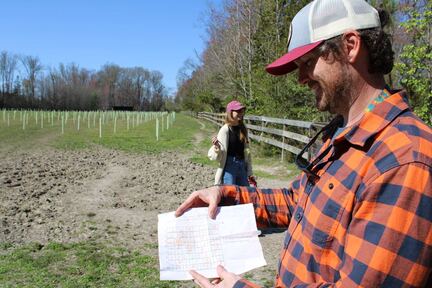 New Land, New Trees In Fall of 2021, Downtown Greens inspired our community by purchasing 56 acres of greenspace alongside Braehead Farm in the City of Fredericksburg. This once-in-a generation conservation purchase will protect clean water resources for the Rappahannock River, enhance habitat and wildlife corridor, and grow Fredericksburg’s capacity to inspire and educate the next generation of conservation stewards. This spring, Friends of the Rappahannock (FOR) had the privilege to assist Downtown Greens and other local partners as they established a new riparian buffer using native fruit, nut and berry trees. Here’s some more about our collaboration with Downtown Greens. How did this project get started? In 2022, Downtown Greens executive director Sarah Perry approached FOR to learn about how her organization could enhance the wildlife and environmental value of their newly obtained property. FOR suggested that reforesting approximately 3 acres of pasture alongside two streams– a technique known as a riparian buffer–could help improve water quality by filtering runoff, absorbing pollutants and reducing erosion and sedimentation. But this was no ordinary riparian buffer. What’s so special about this project? It is an edible riparian buffer. To align with Downtown Greens’ food mission, this project uses only native fruit, nut and berry trees. Our species list included American persimmon, black cherry, hazelnut, wild plum, Eastern serviceberry, paw paw, elderberry and red mulberry. This project is also the largest single tree planting in the City of Fredericksburg that FOR has ever organized, at 810 trees. To achieve such a large-scale forest at minimal cost, the trees were planted as 18” bare-root saplings and each was protected using a plastic tube and wooden stake. Who contributed to this project? This project couldn’t have succeeded without contributions from numerous community members and organizations. The project was funded using a cost-share from the Tri County Soil and Water Conservation District and the designed with help from the Virginia Department of Forestry. The trees were planted entirely with volunteer labor between March 11-23 with help from numerous groups including Tree Fredericksburg, the Central Rappahannock Master Naturalists, the Stafford High School Planting Shade Club, Fredericksburg Tree Stewards and the University of Mary Washington. Between March 20-22, 120 students from James Monroe High School planted the final 310 trees as part of their Meaningful Watershed Education Experience (MWEE) program, funded by NOAA’s Bay Watershed and Education and Training (BWET) program. What’s next? Over the next several years and decades, the trees–which were planted as 18” saplings– will mature and begin to produce nuts, fruit and berries, becoming a showcase for Virginia native plants–a “forage forest.” FOR, students and researchers will monitor the streams to determine how water quality and wildlife are responding to the new forest. Meanwhile, the planting area will be mowed regularly and kept free of invasive plants or browsing animals. Eagle Scout Justin Murray is enhancing the existing fence using deer wire to reduce browsing. As Downtown Greens moves ahead in developing its new land, this edible forest will ultimately be accessible to the public to enjoy. Please visit Downtown Greens’ website at www.downtowngreens.org to learn more about their new land. Adam Lynch serves as a River Steward for Fredericksburg, Spotsylvania and Stafford with Friends of the Rappahannock. This article was originally published in the May 2023 edition of Front Porch Magazine. Read the full publication by using the link below.
0 Comments
 Don’t Mock the Strawberries Is there anything more perfect than the flavor of a wild strawberry? It’s that time of year again when lawns and gardens alike get covered in strawberry plants. But beware! Most of the “strawberries” we see growing wildly now are imposters! Enter 'Duchesnea indica', or Mock Strawberry! Native to India, his deceptive little berry grows invasively in our area. While it is mostly harmless (allergic reactions have been documented) and edible, the flavor is almost nonexistent and it will gleefully crowd out other ground covers. But we do have a native wild strawberry, 'Fragaria virginiana' or Virginia Strawberry, that, while tiny, packs a sweet strawberry flavor! How to tell the difference? One way is to pick the strawberry and crush it between your fingers. Wild strawberries will have a strong and distinct strawberry scent whereas the mock strawberry will smell watery. Another way to tell the difference is to check out the bloom! The mock strawberry will have 5 yellow petals per bloom whereas the wild strawberry will have 5 white petals, much like the ones you grow in your garden. The shape of the berry is another way to tell the difference. Mock strawberries are very round like a ball and actually grow upright on top of their stems. Wild strawberries will have the classic strawberry shape, if a bit smaller, and will hang down on the stems, again, like the strawberries you see growing in gardens. Janet Douberly is very round, like a Media Manager, at Downtown Greens. This article was originally published in the May 2023 edition of Front Porch Magazine. Read the full publication by using the link below. |
AuthorWrite something about yourself. No need to be fancy, just an overview. Archives
February 2024
Categories |
 RSS Feed
RSS Feed